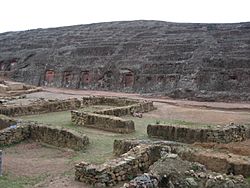Chané facts for kids

El Fuerte de Samaipata, Chané ruins that predate the Inca, Samaipata, Bolivia
|
|
| Total population | |
|---|---|
| 1,500 | |
| Regions with significant populations | |
| Languages | |
| Chiriguano, Spanish, formerly Chané language (an Arawakan language) | |
| Religion | |
| Animism, Christianity (Roman Catholicism, Anglicanism) |
The Chané are a group of people who speak an Arawakan language. They are the southernmost Arawakan-speaking people. They used to live in the flat lands of the northern Gran Chaco region. They also lived in the hills of the Andes mountains. Their homes were in parts of Paraguay, Brazil, Bolivia, and Argentina.
Historically, there were two main groups of Chané. The first group, called the Chané proper, lived in eastern Bolivia. The second group, called the Guaná, lived in Paraguay and nearby Brazil. Today, some Chané survivors are the Izoceño people in Bolivia. In 2010, about 3,034 descendants were counted in Argentina. The Guaná survivors are the Tereno and Kinikinao people. They live in the Mato Grosso do Sul province of Brazil.
Many historical Chané people became part of the Eastern Bolivian Guarani group. These Guarani people were often called Chiriguanos. The Guaná people, on the other hand, were connected to the Mbayá. The Mbayá were a group who spoke a Guaycuruan language.
Contents
Chané History: How They Lived
The Chané, like other Arawak groups, likely came from northeastern South America. They are thought to have moved south about 2,500 years ago. They developed a farming culture. They built villages where many people lived closely together.
They grew crops like corn, peanuts, cotton, and squash. The Chané were also known for their amazing pottery and artwork. These items have been found in areas around Santa Cruz de la Sierra in Bolivia. Other important sites include Samaipata, Portachuelo, and Cotoca. They also made wooden masks and clothes from fabric.
An ancient Chané religious site is El Fuerte de Samaipata. It dates back to around 300 CE. Today, it is a UNESCO World Heritage Site. This means it is a very important place for everyone to protect.
Chané Interactions with Other Groups
The Chané were generally a peaceful culture. They traded goods with the Quechua-speaking Incas. The Incas lived in the Andes mountains. The Chané also traded with other Arawak-speaking groups. These groups lived to the north and east.
The Chané and Incas made an agreement to work together. They wanted to fight against the Eastern Guarani peoples. These Guarani lived in the foothills of the Andes. The Incas and Spanish called them Chiriguanos. The Chiriguanos often attacked the Chané homeland. Before the Spanish arrived, the Chiriguanos defeated the Chané. They also stopped the Inca from moving into the plains and valleys. These areas are now part of the Santa Cruz Department of Bolivia.
Some Chané were forced to work for the Chiriguanos. Others moved to less fertile areas to the southeast. Many Chané women married Chiriguano men. This led to the two groups mixing over time. Both Guarani and Guaraní-speaking Chané also mixed with Europeans. This happened during the colonial period. It continued after Argentina and Bolivia became independent countries.
The Guaná People
The Guaná, also known as Layaná, are the eastern part of the Chané people. They were connected to the Mbayá people. The Guaná worked for the Mbayá. This relationship existed in 1548, according to Spanish records. It might have started even earlier.
The Guaná were farmers and traveled on foot. The Mbayá, however, were nomadic. They became skilled horse riders by the early 1600s. In the early 1700s, the Guaná lived in seven large villages. Each village had 1,000 or more people. These villages were on the western side of the Paraguay River. Later in the 1700s, some Guaná moved east of the river with the Mbayá.
In the early 1700s, there were perhaps 18,000 to 30,000 Guaná people. By 1793, their number was about 8,200.
Guaná and Mbayá Relationship
The Guaná provided the Mbayá chiefs with workers and farm products. They also gave them textiles and wives. In return, the Mbayá protected the Guaná. They also gave them European goods, like iron tools. Over time, the cultures of the Guaná and Mbayá became more similar. The Mbayá started farming and weaving. The Guaná began to ride horses.
Spanish writers described the Guaná as peaceful. They said the Mbayá were proud. But they were also surprisingly kind and respectful to the Guaná people who worked for them.
By 1850, the Guaná had ended their relationship with the Mbayá. They were living near Miranda, Mato Grosso do Sul, Brazil. The largest group of Guaná was the Tereno. There were about 3,000 to 4,000 of them at that time. In 2001, they were called the Terêna. About 16,000 of them were living in the same area.
Where Chané People Live Today
Some Chané communities still live in the Izozog region. This is in Santa Cruz, Bolivia. Others live in Yacui and Che-Renda, near Tartagal, Argentina. In both places, their language and culture have been influenced by the Guaraní. However, they still keep their Chané identity.
Other descendants of the Chané culture mixed with the Guaranis first. Later, they mixed with Spaniards. In the last two centuries, they mixed with people from Europe and Arab countries. They also mixed with migrants from other parts of Bolivia and Argentina. The Chané culture is an important part of the history of people in Santa Cruz. It is also important in the Paraguayan Chaco, Salta Province, Jujuy Province, and the Argentine Chaco.
See also
 In Spanish: Chanés para niños
In Spanish: Chanés para niños
- Arawak
- Chané language
- Maipurean languages

